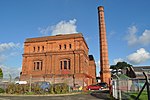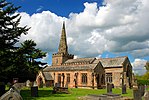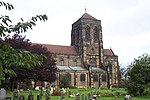Monks Bridge, River Dove
Arch bridges in the United KingdomBridges in DerbyshireBridges in StaffordshireRoad bridges in EnglandScheduled monuments in Derbyshire ... and 1 more
Scheduled monuments in Staffordshire

Monks Bridge is a road bridge across the River Dove between Stretton, Staffordshire, and Egginton, Derbyshire. A bridge has existed here since the early 13th century, though much of the current structure dates to the 15th century. It formerly carried traffic on what is now the A38 road but a replacement structure was built to the north in 1926. It was formerly used as a slip road but is now out of use to vehicular traffic.
Excerpt from the Wikipedia article Monks Bridge, River Dove (License: CC BY-SA 3.0, Authors, Images).Monks Bridge, River Dove
East Staffordshire Stretton
Geographical coordinates (GPS) Address Nearby Places Show on map
Geographical coordinates (GPS)
| Latitude | Longitude |
|---|---|
| N 52.839722222222 ° | E -1.6030555555556 ° |
Address
DE65 6HA East Staffordshire, Stretton
England, United Kingdom
Open on Google Maps







